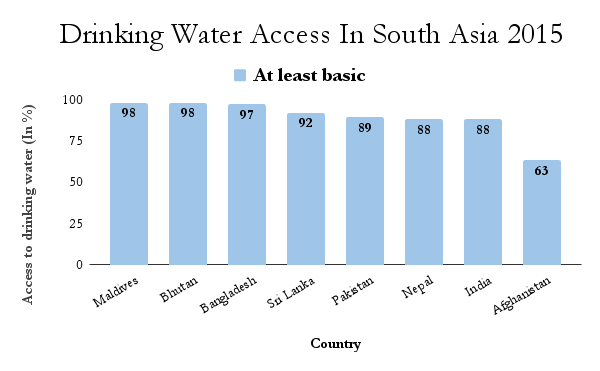In 2015, India Better Only Than Afghanistan In South Asia In Providing Access To Basic Drinking Water Services
With 88% of its population able to access “basic drinking water services” in 2015, India ranked 165 among 233 countries/regions globally, according to the 2017 report of the Joint Monitoring Programme for Water Supply, Sanitation and Hygiene produced by the World Health Organization and UNICEF. The global average was 89%.
Among its South Asian neighbours (Afghanistan, Bangladesh, Bhutan, Maldives, Nepal, Pakistan, Sri Lanka), India ranked better only than Afghanistan, where 63% of the population had access to basic drinking water services.
The report, published on July 12, 2017, evaluated 233 countries/regions globally based on the percentage of population that sourced its drinking water from ‘basic services’, ‘limited services’, ‘unimproved services’ of water or from ‘surface water'.
Source: Progress on drinking water, sanitation and hygiene
Basic services: Drinking water from an improved source, provided collection time is not more than 30 minutes for a round trip, including queuing;
Limited services: Drinking water from an improved source for which collection time exceeds 30 minutes for a round trip, including queuing;
Unimproved services: Drinking water from an unprotected dug well or unprotected spring;
Surface water: Drinking water directly from a river, dam, lake, pond, stream, canal or irrigation canal.
In 2015, 4% of India’s population sourced its drinking water from ‘limited services’, 7% from ‘unimproved services’ and 1% from surface water; the global average was 4%, 6% and 2%, respectively.
(Vivek is an analyst with IndiaSpend.)
We welcome feedback. Please write to respond@indiaspend.org. We reserve the right to edit responses for language and grammar.
__________________________________________________________________
“Liked this story? Indiaspend.org is a non-profit, and we depend on readers like you to drive our public-interest journalism efforts. Donate Rs 500; Rs 1,000, Rs 2,000.”



